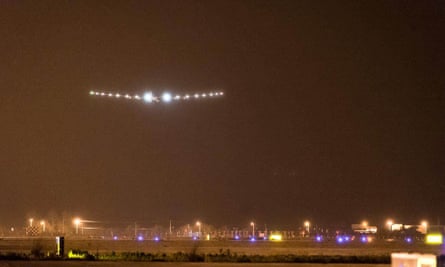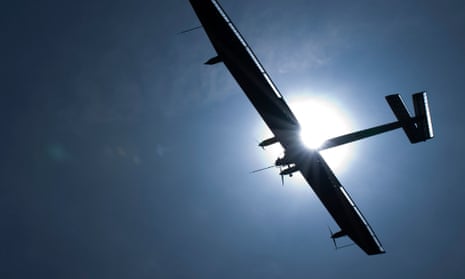A Swiss pilot and his craft powered by nothing but sunlight will launch an attempt to cross the Pacific Ocean on Monday in what will be the longest solo plane flight in history.
For five days and nights, André Borschberg and his solar aircraft will battle exhaustion, discomfort and technological limitations as they cross the lonely 5,000 miles of ocean that swallowed Amelia Earhart 78 years ago.
Since beginning their circumnavigation of the world in Abu Dhabi in March, Borschberg and his flight partner Bertrand Piccard have been piloting the single-seater Solar Impulse II on alternating legs of up to 20 hour, breaking records for solar flight as they go. But Borschberg’s flight from Nanjing in China to the islands of Hawaii will dwarf all their previous feats, and smash the previous endurance record for solo flight in any plane by around two days.
“The next leg is what I call the moment of truth,” he said. “The first time we fly many days, many nights with a solar-powered airplane, the first time that we fly over the ocean, the first time that one pilot flies alone for so long. We are exploring new territories.”
Following Borschberg’s arrival in Hawaii, Piccard will fly on to Phoenix, Arizona – a journey of similar length.
“Now in front of us we have the biggest ocean of the world,” said Piccard. “When I initiated this project, 14 years ago now, I really had this vision of an aeroplane flying day and night with no fuel. So I’m in one of the most important moments of my life. Is my vision going to become a reality?”
Saving power will be the key to a successful crossing. At full clip the the plane will reach a glacial 87mph, one-seventh the speed of a Boeing 747. Its wings and fuselage are plated with 17,000 photovoltaic solar cells.
The need to balance weight against battery storage means the flight will end every night on a knife edge. More than a quarter of the aircraft’s 2.3 tonnes comes from a bank of lithium batteries that will store just enough energy to fly through the night – a feat the Solar Impulse team were the first to manage in a solar-powered plane.
During the day, the pilots will climb to an altitude of 9,000m. But as the sun disappears, they will power down the propellors and glide. Using the motors sparingly the plane will drop to 1,000m – below the clouds. As day breaks, they will have just 5-10% battery capacity and will have to find a clear patch of sky or risk plunging into the ocean.
“We are really at the limit of what the technology can provide,” he told the Guardian from Nanjing, where the plane has been grounded for more than a month waiting for a weather pattern that will allow him to make the crossing. “The step we make forward is huge. We didn’t have the chance to test this airplane day and night, we never flew over the oceans. There is no way to go back, so when you leave the coast of China you are committed to go to Hawaii, you are committed to fly five days five nights. You have to go to the end. That’s what’s exciting but it’s also what is very challenging.”
Piloting the plane into clear skies will require constant attention, meaning the pilots will snatch sleep in 20-minute naps. Both will practice meditation and yoga (adapted to the cramped cockpit) in order to cope with the mental adversity. Borschberg said the external adventure would be mirrored by his own “personal exploration”.
“The only way to do it in fact is to live in the present moment. If I start thinking about how many hours remains, how many days remains then you really start to be in a stress situation. So the only way is to enjoy every minute,” said Borschberg. “You have the pleasure to enjoy sunrise and sunset, beautiful views on the ocean. It can be an immense blue volume below and above. So the beauty will be spectacular.”
Across its 14 year adventure, the Solar Impulse project has broken numerous records and new technological barriers. The team are realistic that a solar powered commercial airliner is a long way off, but they say their innovations in energy efficient engines and materials can be used in homes across the world.
Piccard said the circumnavigation, which has visited Oman, India and Burma on the way to Nanjing, has engaged with schools, businesspeople, activists and politicians on the ground to promote innovation and clean energy solutions.
He said the reception in China in particular was overwhelming. “The media got really excited. Social media, official newspapers, television. Everywhere, all the time. They were really sensitive to the message of clean technologies. People tend to say in China they pollute and they don’t care. It’s not true. They care a lot and they know they need to invest more in clean technologies.”


Comments (…)
Sign in or create your Guardian account to join the discussion